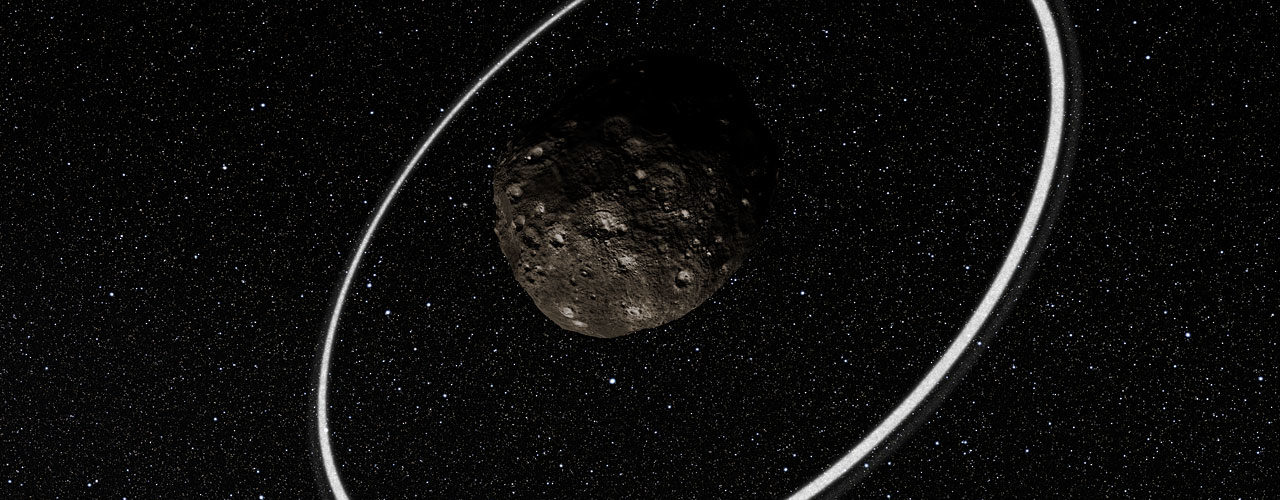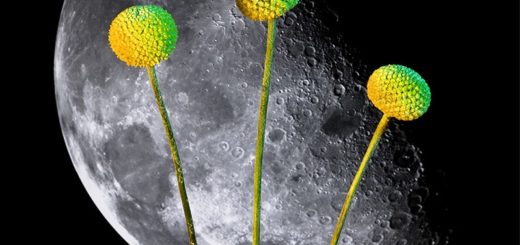Small bodies with Saturn-like rings and unusual dynamics

Saturn is well known for its extremely bright rings, while Jupiter, Uranus, and Neptune have much dimmer ring systems. Looking beyond the planets, a new era of discovery is underway.
In 2013, two rings were detected around the centaur Chariklo – 7 km and 3 km in width separated by a 9 km gap. Chariklo has a diameter of 302km and is the largest member of a group called ‘centaurs’. Centaurs are icy objects which are thought to have originated in the Kuiper Belt, and capable of exhibiting properties of asteroids and comets. They have orbits, between Jupiter and Neptune, which can cross the paths that the giant planets travel around the Sun. When centaurs closely approach a planet, the planet’s gravity can change their orbit. Occasionally a ring system could be disturbed or pulled apart depending on the closeness of an approach. Chariklo’s system of rings were surprising since it demonstrated that a centaur can indeed host rings.
The possibility of two rings around another centaur, Chiron, arose in 2015. Telescopes observed Chiron as it passed in front of a distant star, blocking the starlight. Astronomers detected two symmetrical features in the starlight data, one before and one after Chiron’s pass. Here, the material near Chiron caused the light to dim further1.
Observations of Chiron from the 1990s spotted similar features and it was concluded that this resulted from jets of material from the surface. The MIT researchers agree with this conclusion, but say that a shell of gas and dust around Chiron, or a ring system, cannot be ruled out either due to the symmetry of the features.
Interestingly, a study has shown that for simulations of 729 ‘clones’ of Chariklo, with similar orbits, more than 90% of them would keep rings after close approaches with the giant planets. This supporting research means the existence of rings around Chiron and more centaurs may be more likely and are certainly worth further investigation as there’s roughly 44,000 of them!
Outside of centaurs, the first ring around a trans-Neptunian object was detected in 2017 around the dwarf planet Haumea2. To understand how rings around these small bodies formed (e.g. collisions or tidal forces), astronomers are studying their nature and interactions. Specifically, they are searching for whether the rings will spread out and disappear from ring particle collisions, or if there is some process which keeps them confined.
When Chariklo’s rings were detected, ‘shepherd moons’ – a few kilometres in size – were thought to have caused the narrow rings and gap. Shepherd moons are small satellites which act to keep the ‘flock’ of ring particles confined by altering their orbits. Each time the moon passes by a particle, it exerts a tug on it at the same position in their orbits3. Eventually, enough tugs will change the particle’s orbit.
This alignment of objects happens due to ‘orbital resonances’, which are distinct relationships between astronomical objects. These occur when the orbital period of objects (the time it takes them to complete a full orbit of another, more massive, astronomical object) gives a whole number ratio. For example, 2:1 means the ring particles make 2 orbits for every 1 orbit of the moon. If there is no such mechanism, then the rings will spread out in a few thousand years.
The fact that we can detect these rings means they are either relatively young and haven’t begun to spread out yet, or there is something keeping them in place; otherwise the rings would have dissipated. Research led by Bruno Sicardy of the Observatoire de Paris, suggests that there may be another mechanism in play, unique to small bodies4. The scientists propose that gravity and ‘odd shapes’ act to confine the narrow rings. Chariklo is rocky, elongated, and has a ‘large mountain’. Haumea is even more elongated, completing one spin in about 4 hours. Such physical features and elongated bodies are said to take on a role similar to a shepherd moon by producing resonances between the ring particles’ orbit and the body’s spin5.
These resonances clear particles from the region where their orbital period equals the body’s spin rate, the ‘synchronous orbit’. Particles within this region fall onto the body and particles outside move outwards past the 1:2 resonance, where particles make 1 orbit for every 2 spins of the body. We see this with Chariklo and Haumea which have narrow rings at approximately 100km and 540km, respectively, away from their 1:2 resonances6. These narrow rings mean some particles did indeed move outwards, and are now well-confined into a tightly-packed ring system. Particularly, Haumea’s ring follows a path close to its 1:3 resonance7.
Exactly how narrow rings around small bodies stay confined is an exciting, developing area of research. Continuing to search and study the solar system – planets and beyond – we can learn more about these bodies and how they interact.
Edited by Frankie Macpherson
References
- www.sciencedaily.com/releases/2015/03/150316122732.htm
- www.sciencedaily.com/releases/2017/10/171012093350.htm
- www.natureasia.com/en/research/highlight/10162
- https://news.cornell.edu/stories/2018/11/odd-bodies-rapid-spins-keep-cosmic-rings-close
- https://astronomycommunity.nature.com/users/181583-bruno-sicardy/posts/40090-the-dynamics-of-pocket-rings
- www.iaa.csic.es/en/news/complex-dynamics-miniature-ring-systems-solar-system
- https://phys.org/news/2019-05-scientists-dwarf-planet.html










